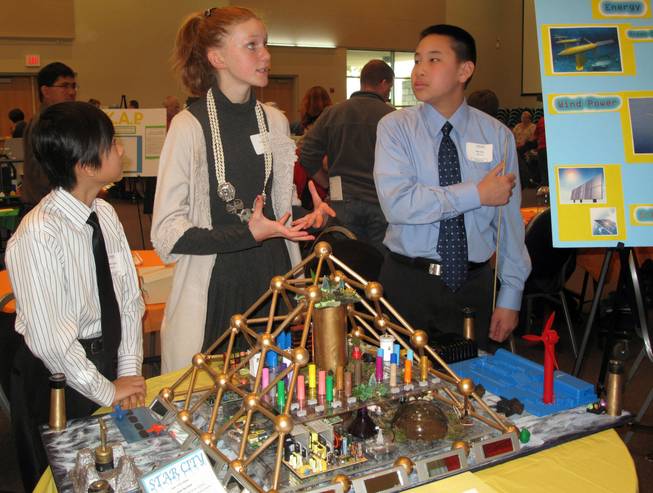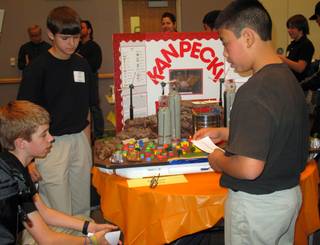
Clark County middle school students gathered at Northwest Career and Technical Academy Saturday to compete in the Future City Competition. Teams of students built tabletop model “future cities” built on alternative energy resources.
Saturday, Jan. 21, 2012 | 4:47 p.m.
Imagine a city where the sidewalks are replaced with sand and energy is found in citrus fruits. How about living in a city with only public transportation? Or even a coastal city where energy is produced by hydrogen and algae synthesis?
These “cities” were created by the minds of Clark County sixth-, seventh- and eighth-graders enrolled in the Future City Competition class.
Students from 11 Clark County middle schools filled rooms at Northwest Career and Technical Academy on Saturday as they presented their model cities in the annual Future City Competition. This year’s theme was alternative energy resources that maintain a healthy planet.
These students are getting first-hand experience in the world of engineering, some by signing up for a yearlong elective class; others have grouped together for an extracurricular activity. Their goal: to make it to nationals.
Regional co-coordinator Olivia Furlan said the competition, now in its 20th year, strives to give middle school students a better picture of what it's like to be an engineer.
“When it comes to engineering, people don’t know what engineers look like, what they do,” Furlan said. “Future city is a great way to introduce to sixth-, seventh- and eight-graders what that role is in society.”
Come judging time, students are expected to have completed all five components of the competition: they must build a scale physical model of their original city; write a 1,000-word essay; write a city narrative; build the city virtually in SimCity, a virtual city-building simulation game; and give a five-minute oral presentation.
When selected, the winning group gets a trip to compete at the national level in Crystal City, Va. The prize: a trip to space camp.
Southern Nevada has been represented at nationals for 14 years but has never won the national Future City Competition. Furlan said the experience alone does wonders for kids whose interest in science is sparked by the competition.
“Students go on to work for NASA, become doctors, become engineers,” Furlan said. “There are students who have gone on to have patents from the discoveries that they made during Future City.”
•••
Four eager teams from Ernie Rambo’s class at Walter Johnson Junior High presented their cities Saturday morning.
Rambo, who has taught the class for more than five years, said her students dedicate endless hours to the project.
“It is a way for them to apply all the things they are learning about in their other classes — definitely their science knowledge, mathematics, in particular, ratio and proportion,” Rambo said.
But science and math aren’t the only things Rambo hopes her students will learn.
One former autistic student, she said, would rarely communicate with others. After joining her class he became a group leader and eventually led his team presentation. Rambo said after that experience he felt comfortable enough to try out for a spot at the Las Vegas Academy of International Studies, Performing and Visual Arts, where he now plays the bass.
“This experience, while we think of it as science and engineering and careers, it brings out some other talents that (students) have,” Rambo said.
•••
“I’ve always been interested in science,” said Jose Favella.
Favella’s group, also from Johnson Junior High, created a city powered by hydrogen and wind energy called HydroCity. After presenting, he and his partners, Nick and Alex Anderson, placed their intricate model display in the hallway for others to see.
What they are most proud of? The fact that 99 percent of their model was built by recyclable products like McDonald's drink holders, old prescription bottles and used printer cartridges.
“We had some difficulties, and we had to debate what we wanted,” said Alex Anderson. “The most challenging part of the model would probably be the lighthouse and the roads took about two hours.”
Although they say it would be nice to win, the boys — all sixth-graders — said they wouldn't be mad if they don’t because there is always next year.


Join the Discussion:
Check this out for a full explanation of our conversion to the LiveFyre commenting system and instructions on how to sign up for an account.
Full comments policy